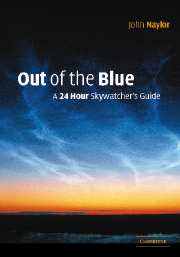Book contents
- Frontmatter
- Contents
- Preface
- Introduction
- 1 Daylight
- 2 Shadows
- 3 Mirages
- 4 Sunset and sunrise
- 5 Rainbows
- 6 Coronae and glories
- 7 Atmospheric halos
- 8 The night sky
- 9 The Moon
- 10 Eclipses
- 11 Planets
- 12 Stars
- 13 Comets and meteors
- APPENDIX: Technical and practical advice for skygazing
- Glossary
- Further reading
- Sources and notes
- Index
- Frontmatter
- Contents
- Preface
- Introduction
- 1 Daylight
- 2 Shadows
- 3 Mirages
- 4 Sunset and sunrise
- 5 Rainbows
- 6 Coronae and glories
- 7 Atmospheric halos
- 8 The night sky
- 9 The Moon
- 10 Eclipses
- 11 Planets
- 12 Stars
- 13 Comets and meteors
- APPENDIX: Technical and practical advice for skygazing
- Glossary
- Further reading
- Sources and notes
- Index
Summary
It is a strange thing how little in general people know about the sky. It is the part of creation in which nature has done more for the sake of pleasing man, more for the sole and evident purpose of talking to him and teaching him, than any other of her works, and it is just that part in which we least attend to her
John Ruskin: Modern Painters, vol. 1, section III, ch.1 ‘Of the Open Sky’The colour of the daytime sky
Our atmosphere is a thin, transparent layer of air, not much more than 100 km deep, that separates us from the dark and starry void beyond. On cloudless nights we look out at this fathomless darkness, and only the twinkling of stars betrays the presence of the atmosphere through which we gaze. But when the Sun is up, the whole sky glows brightly, and the dark abyss is concealed from us by an almost tangible blue dome that seems forever out of reach, beyond even the highest clouds and the furthest horizon.
There is no blue dome, of course. Instead during daylight hours we are immersed in what is known as airlight, which is the glow of the atmosphere when it is illuminated by the Sun.
- Type
- Chapter
- Information
- Out of the BlueA 24-Hour Skywatcher's Guide, pp. 5 - 28Publisher: Cambridge University PressPrint publication year: 2002

